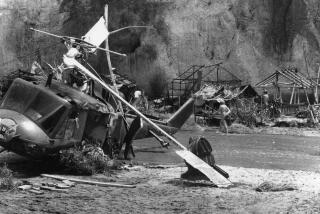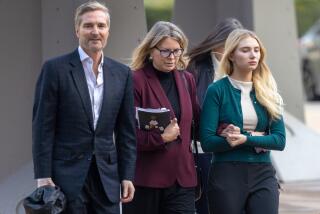Witness in ‘Twilight’ Case Reverses Self
- Share via
A key witness in the “Twilight Zone” trial reversed himself on the witness stand Monday, supporting a prosecution theory that a last-minute change in a helicopter’s flight path preceded the crash that killed actor Vic Morrow and two children.
The reversal came early in afternoon testimony by James Camomile, a special-effects technician whom the defense blames for the crash.
In the morning, Camomile had said the helicopter was in the same position at 2:20 a.m. on July 23, 1982, just before it crashed, as it was during a run-through 20 minutes earlier.
“Did you ever testify it was not?” asked Deputy Dist. Atty. Lea Purwin D’Agostino.
“I can’t say for sure,” replied Camomile, whose testimony has been billed by the defense as crucial to the trial of director John Landis and four others.
D’Agostino, apparently surprised by his statement, asked for a recess to consult her notes on Camomile’s previous accounts of the incident.
“I think he’s nervous and confused,” she said outside court.
Immediately after the lunch break, Camomile changed his story when asked by D’Agostino whether he remembered more clearly where the helicopter was located during the final scene.
He told her he thought it was a little closer to the shoreline than it had been before, then faced cross-examination by the defense.
Several other witnesses have said the helicopter was lower and closer to a cliff than it had been during previous flights.
Morrow, 53, Myca Le, 7, and Renee Chen, 6, were killed when the chopper crashed on them. Landis, associate producer George Folsey, production manager Dan Allingham, special-effects coordinator Paul Stewart and pilot Dorcey Wingo are charged with involuntary manslaughter. Prosecutors say they behaved recklessly, failing to consider safety.
Camomile testified under a grant of immunity from prosecution, which he received early in the case.
He has admitted that he fired a series of explosions that engulfed the helicopter before it went into a spin.
Attorneys for Landis and the four co-defendants claim that Camomile was not paying attention to the Vietnam War scene being shot and fired his bombs before Morrow and the two children were out of the line of fire.
The defense contends that the crash was an unforeseeable accident and that the film makers took adequate precautions.
Camomile, beginning what was expected to be a long stint on the witness stand, supported the prosecution position that Landis ordered huge explosions for the final scene.
“This was to be the finale, the destruction of the village,” Camomile recalled. He said he was told to place an explosive mortar under a hut because Landis wanted “to see the shack go up.”
The prosecutor claims that the force of that explosion sent pieces of the hut into the helicopter’s control mechanism, causing the crash. The defense disputes this.
Camomile said there was so much debris flying around on the set during previous scenes that he asked for and received a welding hood to protect his eyes.
‘There were a lot of rocks, water flying in the air, making visibility difficult,” he said.
Camomile acknowledged that other children, from families of the crew members, had been removed from the set because of the volatile nature of the explosions.
Asked why the children were kept away, he said, “Because of the inherent danger or possibility of something happening.”
More to Read
Sign up for Essential California
The most important California stories and recommendations in your inbox every morning.
You may occasionally receive promotional content from the Los Angeles Times.










